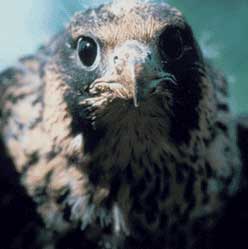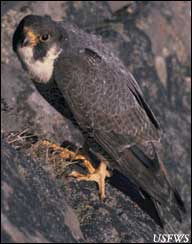Fastest Creature on Earth
 The relationship between Peregrine Falcons and humans goes back thousands of years. Once highly prolific and widespread throughout the world, Peregrine Falcons were commonly used throughout Europe, Asia and the Middle East in the practice of Falconry. Peregrines are naturally docile and easily lent themselves to taming by humans who saw the Falcon's hunting prowess as an asset in hunting for food. The Peregrine’s magnificent speed and power also made it the favorite bird for falconers in the Middle Ages. The female, which is slightly larger and more powerful than the male, was preferred, and only she is given the title of “falcon.” A male Peregrine is referred to as a “tiercel” meaning third. Although falconry has fallen out of favor, there are still those who practice it today.Masters of the Hunt
The relationship between Peregrine Falcons and humans goes back thousands of years. Once highly prolific and widespread throughout the world, Peregrine Falcons were commonly used throughout Europe, Asia and the Middle East in the practice of Falconry. Peregrines are naturally docile and easily lent themselves to taming by humans who saw the Falcon's hunting prowess as an asset in hunting for food. The Peregrine’s magnificent speed and power also made it the favorite bird for falconers in the Middle Ages. The female, which is slightly larger and more powerful than the male, was preferred, and only she is given the title of “falcon.” A male Peregrine is referred to as a “tiercel” meaning third. Although falconry has fallen out of favor, there are still those who practice it today.Masters of the Hunt
 The relationship between Peregrine Falcons and humans goes back thousands of years. Once highly prolific and widespread throughout the world, Peregrine Falcons were commonly used throughout Europe, Asia and the Middle East in the practice of Falconry. Peregrines are naturally docile and easily lent themselves to taming by humans who saw the Falcon's hunting prowess as an asset in hunting for food. The Peregrine’s magnificent speed and power also made it the favorite bird for falconers in the Middle Ages. The female, which is slightly larger and more powerful than the male, was preferred, and only she is given the title of “falcon.” A male Peregrine is referred to as a “tiercel” meaning third. Although falconry has fallen out of favor, there are still those who practice it today.
The relationship between Peregrine Falcons and humans goes back thousands of years. Once highly prolific and widespread throughout the world, Peregrine Falcons were commonly used throughout Europe, Asia and the Middle East in the practice of Falconry. Peregrines are naturally docile and easily lent themselves to taming by humans who saw the Falcon's hunting prowess as an asset in hunting for food. The Peregrine’s magnificent speed and power also made it the favorite bird for falconers in the Middle Ages. The female, which is slightly larger and more powerful than the male, was preferred, and only she is given the title of “falcon.” A male Peregrine is referred to as a “tiercel” meaning third. Although falconry has fallen out of favor, there are still those who practice it today.Peregrine Falcons are raptors, which means they are birds that hunt and kill for food. They are very well adapted to the hunt; with strong, sharp, curved beaks for tearing flesh; large, keen eyes for viewing prey at great distances; and sharp, powerful claws (called talons) for clutching and grasping
Other birds, such as pigeons, blackbirds, ducks, and pheasants, are the falcons' usual prey. Peregrines' incredible speed is the primary weapon used to kill their prey during the hunt. When they get ready to strike, they close their talons and strike the bird in a plunging dive, usually knocking the bird unconscious with a single blow. The force of the initial strike is so severe that the bird is usually killed on impact. As the victim falls through the air the falcon circles back and picks its prey out of the air with its claws. If the bird survives the initial blow, the Peregrine will break its neck with a quick ’s spine.
Fascinating FactsThe Peregrine Falcon is easily recognizable as distinct from other raptors. It has black feathers on its head, sort of in the pattern of a helmet, with dark feathers around its beak that look kind of like a dark mustache (remember "mutton chops" in the 1970s?) You could say it looks like a "biker hawk". The feathers on its back are dark, with a bluish cast. The tips of the falcon's wings are very sharply "pointed", making a
 |
The peregrine is the fastest bird on record reaching horizontal cruising speeds of 65-90 kph ( 40-55 mph) and not exceeding speeds of 105-110 kph (65-68 mph). When stooping, the peregrine flies at much greater speeds, however, varying from
Pairs of Peregrines mate for life, usually setting up housekeeping high in the cliffs. Since we're running out of cliffs in Europe and the U.S., Peregrines have taken to building their nests up on top of high-rise buildings in large cities. Peregrine nests are called scrapes, or eyries and baby falcons are called eyasses. Although they have a high mortality rate, Peregrines have been known to live as long as 15 years.
If you don't believe the stories about the incredible speed of the Peregrine Falcon, then watch the video demonstration of a falcon being clocked at diving speeds of over 200mph!
No comments:
Post a Comment